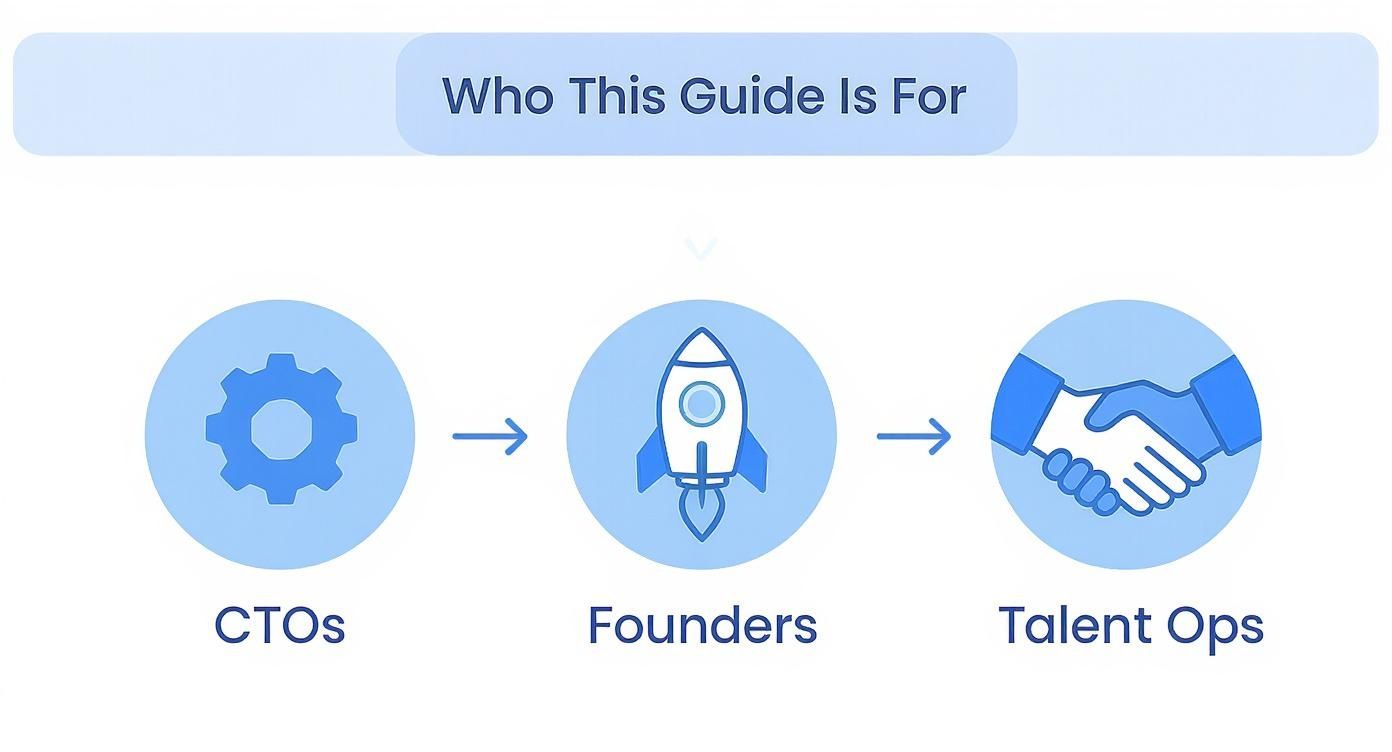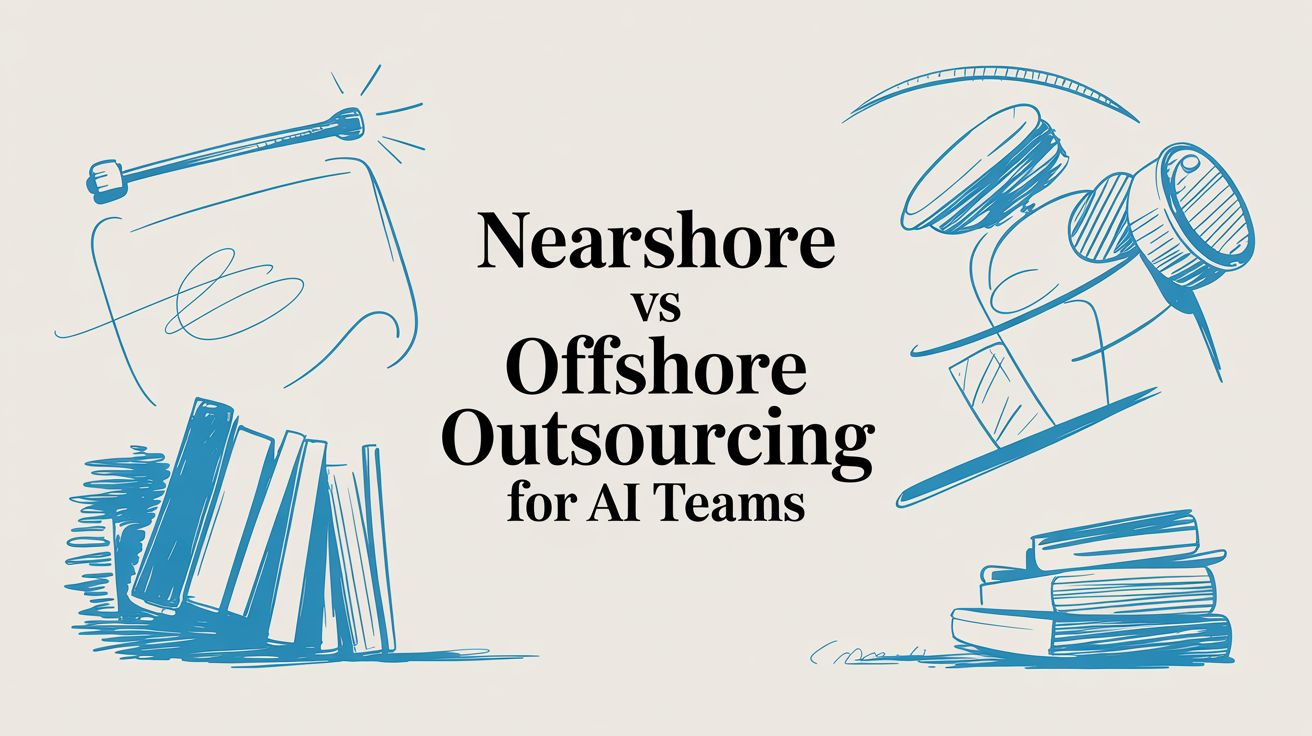TL;DR: Your Quick Outsourcing Playbook
- Go Nearshore for complex projects like AI/ML development that require real-time collaboration. The minimal time zone difference (0-3 hours) is critical for agile teams. Expect higher hourly rates but a lower Total Cost of Ownership (TCO) due to less rework.
- Choose Offshore for well-defined, large-scale projects where cost is the primary driver. It excels for tasks like data migration or QA testing that can be done asynchronously. The 8-12 hour time difference can be a feature for "follow-the-sun" workflows.
- Use a Hybrid Model for the best of both worlds. Assign core, collaborative work (e.g., product strategy, RAG system development) to a nearshore team and high-volume, independent tasks (e.g., data annotation, legacy system maintenance) to an offshore team.
- Start with a Pilot: Before committing, run a 2–4 week pilot project with 1–2 engineers. This is the fastest way to validate communication, skills, and cultural fit with minimal risk.
Who This Is For
This guide is for technical and business leaders who need to hire and manage remote AI or software teams. You're in the right place if you are a:
- CTO or Head of Engineering deciding how to scale your team to meet an aggressive product roadmap without sacrificing quality or breaking your budget.
- Founder or Product Lead scoping a new AI feature and needing to accurately forecast the budget, timeline, and required team structure.
- Talent Ops or Procurement Leader responsible for vetting vendors, mitigating IP and compliance risks, and securing a reliable talent pipeline.
If you have a critical hiring decision to make this quarter, this guide provides a practical framework to act decisively.
 Alt text: Infographic showing icons for CTOs, Founders, and Talent Ops, the primary audience for this guide.
Alt text: Infographic showing icons for CTOs, Founders, and Talent Ops, the primary audience for this guide.
The Quick Answer: A Decision Framework
Choosing between nearshore and offshore outsourcing isn't just about cost. It’s a strategic decision that impacts collaboration, speed, and risk. Use this table to quickly map your project's needs to the right model.
While this table provides a high-level summary, the real decision lies in the details. The following sections will dive deeper into the business impact of each factor. For another great perspective, check out this offshore vs nearshore: a modern guide.
2 Practical Examples: When to Use Each Model
Theory only gets you so far. Let's analyze two common scenarios to see how the choice between nearshore and offshore plays out in the real world.
Example 1: Building a Complex RAG System (Nearshore)
A Series B SaaS company needs to build a Retrieval-Augmented Generation (RAG) system for its knowledge base. The requirements are evolving, demanding tight, daily collaboration between AI engineers, product managers, and designers.
- The Challenge: An asynchronous model would create 24-hour delays for simple questions, killing momentum. The team needs real-time brainstorming and rapid prototyping.
- The Solution: They hired a nearshore team of two Senior AI Engineers and one MLOps Engineer from Latin America. This guaranteed 5–6 hours of daily time zone overlap with their Pacific Time headquarters.
- The Business Impact: The nearshore team integrated seamlessly, participating in all agile ceremonies. They launched a functional RAG pilot in just six weeks. The accelerated time-to-market and minimal management overhead easily justified the moderately higher hourly rates compared to offshore options.
Example 2: Migrating a Legacy Data Warehouse (Offshore)
A large enterprise is migrating its on-premise data warehouse to the cloud. The project scope is massive but meticulously documented. The primary goals are cost reduction and freeing up senior internal engineers for more strategic work.
- The Challenge: The work is predictable and repetitive: data mapping, ETL script conversion, and validation testing. The tasks can be done independently, making real-time collaboration unnecessary.
- The Solution: The company engaged an offshore team of eight Data Engineers and two QA Analysts in Southeast Asia. The 12-hour time difference became an advantage, enabling a "follow-the-sun" workflow.
- The Business Impact: The project was completed 30% under budget compared to US-based estimates. The offshore team ran large data jobs overnight, and the in-house team reviewed the results each morning. For this well-defined project, the offshore model delivered unbeatable cost efficiency.
Deep Dive: Nearshore vs Offshore Trade-Offs
A smart decision requires looking beyond the sticker price. This framework analyzes the key operational and business factors that determine the true success of an outsourcing partnership.
Alt text: A Venn diagram comparing Nearshore and Offshore outsourcing models, highlighting overlapping benefits and unique advantages.
Total Cost of Ownership (TCO)
Confusing a low hourly rate with low total cost is the most common mistake. TCO includes hidden expenses that add up quickly.
- Management Overhead: A 12-hour time difference forces your managers to work odd hours or accept communication delays, adding to burnout and cost. A nearshore team's 0–3 hour difference nearly eliminates this friction.
- Rework Costs: Vague requirements combined with language barriers can lead to building the wrong feature. Fixing these mistakes can cost weeks of development, erasing any initial savings.
- Travel Expenses: Even in a remote world, critical kickoffs may require face-to-face meetings. A flight to a nearshore location is significantly cheaper and faster than a trip across the globe.
A nearshore team might have a 30% higher hourly rate but deliver a 15% lower TCO by reducing rework and management drag.
Talent Availability and Seniority
The global talent pool is not uniform, especially for specialized AI roles.
- Offshore hubs in Asia offer a massive volume of developers for established technologies like web and mobile.
- Nearshore regions in Latin America and Eastern Europe have become centers of excellence for senior-level AI, ML, and data talent. These engineers often have experience with US tech companies and can contribute strategically from day one.
For more on sourcing talent, see our guide on IT outsourcing development.
Collaboration and Communication
The time zone difference directly impacts your workflow.
- Nearshore enables a synchronous model. Your teams can solve problems on a quick call, conduct interactive code reviews, and participate in agile ceremonies together.
- Offshore requires an asynchronous model. This works for well-defined, siloed tasks but becomes a major bottleneck when requirements are fluid or a bug needs immediate, collaborative troubleshooting. A simple question can take 24 hours to resolve.
Time to Hire and Scalability
Both models are faster than hiring locally, but they scale differently.
- Offshore partners excel at spinning up large teams (10+ engineers) quickly for large-scale projects.
- Nearshore partners shine when you need to add individual senior specialists or smaller, highly-skilled teams. You can typically onboard a vetted senior AI engineer in just 2–4 weeks.
IP Security and Compliance
Geography has significant legal implications. Nearshore locations often provide a more familiar legal framework.
- Eastern Europe falls under GDPR (General Data Protection Regulation), offering robust data protection.
- Latin American countries generally have strong IP laws that align with Western standards.
Offshore locations may introduce a more complex legal landscape, requiring extra due diligence from your legal team to manage risk.
Checklist: Is Nearshore, Offshore, or a Hybrid Model Right For You?
Use this scorecard to make a data-driven decision. Score each criterion from 1 (Low Importance) to 5 (Critical Importance) for your specific project.
Interpreting Your Score:
- 20+ Points: Nearshore is the clear choice. Your need for collaboration, agility, and senior talent outweighs the higher hourly cost.
- 12-19 Points: A hybrid model is likely your best bet. Use a nearshore team for core, complex tasks and an offshore team for scalable, independent work.
- <12 Points: Offshore is a strong fit. Your project is well-defined and cost-driven, making it ideal for an asynchronous workflow.
The Multi-Shore Playbook: A Hybrid Strategy
The "nearshore vs offshore" debate is often a false dichotomy. The most effective strategy is often a hybrid, multi-shore model that leverages the best of both worlds.
 Alt text: A diagram illustrating a hybrid multi-shore strategy, with a core nearshore team collaborating with a specialized offshore team on different project components.
Alt text: A diagram illustrating a hybrid multi-shore strategy, with a core nearshore team collaborating with a specialized offshore team on different project components.
In a hybrid model, you assign work strategically:
- Nearshore Core Team: Handles complex product development, AI model training, and architectural decisions that require intense, real-time collaboration.
- Offshore Support Team: Manages well-defined, high-volume tasks like QA testing, data annotation, or Tier 2 support.
This structure gives you the agility of a nearshore team driving your most critical projects, backed by the cost-efficiency and scale of an offshore team. Effective project management and clear documentation are critical for this model to succeed. This approach is common for companies that work with a staff augmentation company to build blended teams.
The market reflects this nuanced approach. While offshore hubs still attract companies for cost-first projects, this detailed analysis of outsourcing statistics shows explosive growth in nearshore demand where tight team integration is non-negotiable.
What to Do Next: 3 Steps to Get Started
You have the framework. Now it's time to act. Follow these steps to validate your choice and build your team with confidence.
- Define Your Pilot Scope: Use the checklist above to clarify your exact needs for a small, well-defined initial project. Identify the 1–2 critical roles you need to fill first.
- Book a Scoping Call: A quick 20-minute chat with an expert can validate your strategy. We can help you align your project goals with the right talent profiles and locations.
- Launch a Risk-Free Pilot: The best way to test the model is to run a 2–4 week pilot project. This gives you concrete data on communication, productivity, and cultural fit before you scale.
Ready to find the right AI talent?
Start a Pilot Project Today or See Sample AI Engineer Profiles
References & Further Reading
- For a deep dive into sourcing technical talent, read our guide on how to hire remote AI developers.
- To understand different engagement structures, explore our analysis of the DevOps as a Service (DaaS) model.
Ready to build your high-performing AI team with confidence? ThirstySprout provides pre-vetted, senior AI and software engineers from the world's top talent hubs. We help you launch a risk-free pilot in weeks, not months.
Article created using Outrank

